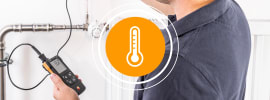- Home
- testo 317-2
testo 317-2 - Gaslekdetector
0632 3172

testo 317-2 - Gaslekdetector
0632 3172Gasleidingaansluitingen kunnen veilig en efficiënt getest worden met de testo 317-2 gaslekdetector. Deze handige gaslekdetector detecteert 2 soorten gas: methaan en propaan. De gasconcentraties worden weergegeven met een balkdiagram. Bovendien geeft de gaslekdetector stijgende gasconcentraties weer aan de hand van een toenemende alarmtoon. Het meettoestel geeft ook een akoestisch signaal wanneer het toestel gebruiksklaar is.
Algemene technische gegevens
| Gewicht | < 300 g |
|---|---|
| Reactietijd | t90 < 5 s |
| Bedrijfstemperatuur | -5 tot +45 °C |
| opwarmtijd | 60 s |
| batterijtype | 2 x AAA micro-batterij (1,5 V, LR03) |
| levensduur batterij | 4 h (LR03) |
| display type | Trendweergave met 8 segmenten |
| Opslagtemperatuur | -20 tot +50 °C |
Methaan
| Meetbereik | 100 tot 20000 ppm |
|---|---|
| ondergrens alarm | 100 ppm |
| 1. alarmgrens | 10000 ppm (20% UEG) |
Propaan
| Meetbereik | 50 tot 10000 ppm |
|---|---|
| ondergrens alarm | 50 ppm |
| 1. alarmgrens | 5000 ppm (20% UEG) |
Gas leak detection in gas pipes in the heated environment
Gas leak detection is the elementary testing of gas pipe parts for existing leaks. A gas pipe is considered leak-proof when there are no gas leaks from the exposed parts. This means that exposed gas pipes in particular are checked for external leak tightness. Leaks are detected by testing a connection point; e.g. at fittings, flanges, screw fittings and gas control valves. It is also important to check ducts entering buildings and gas pipes concealed in cavities at the air outlets. The application can be operated in different ways. A procedure that is still used despite its inherent danger is using a lighter to check the gas pipes. The definitely more usual and safer option is to use foaming media (leak detection foam) which produces bubbles as soon as there is a leak. The most up-to-date way to detect gas leaks is to use an electronic gas detector otherwise known as a “sniffer”.
- Productbrochure testo 316-317(pdf, 1.8 MB)
- Handleiding testo 317-2(pdf, 772.23 kB)






































